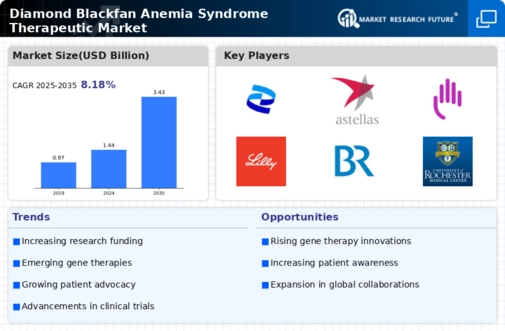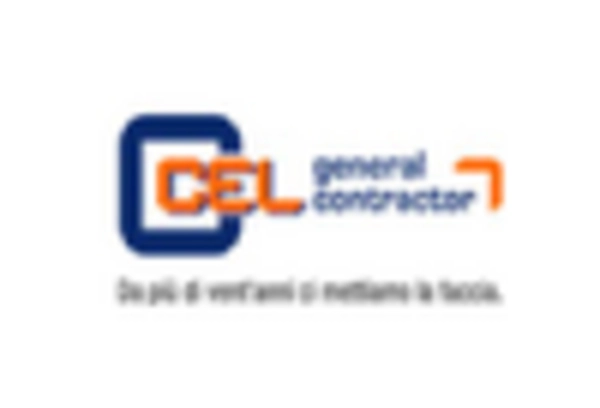Advancements in Gene Therapy
Recent advancements in gene therapy represent a transformative force within the Diamond Blackfan Anemia Syndrome Therapeutic Market. Innovative approaches, such as CRISPR and other gene-editing technologies, hold the potential to address the underlying genetic causes of DBA. These advancements may lead to the development of targeted therapies that not only alleviate symptoms but also correct the genetic defects responsible for the condition. As research progresses, the market could witness a surge in gene therapy trials aimed at DBA, attracting significant investment from pharmaceutical companies. The potential for curative treatments may enhance patient outcomes and reduce the long-term healthcare burden associated with DBA. Thus, the ongoing evolution of gene therapy is likely to play a pivotal role in shaping the future landscape of the Diamond Blackfan Anemia Syndrome Therapeutic Market.
Emerging Therapeutic Options
The emergence of new therapeutic options is a significant driver for the Diamond Blackfan Anemia Syndrome Therapeutic Market. Recent developments in pharmacological treatments, including corticosteroids and novel agents, have shown promise in managing DBA symptoms. These emerging therapies are designed to improve patient outcomes and enhance quality of life. As clinical trials yield positive results, the market is likely to see an influx of new products aimed at treating DBA. Furthermore, the potential for combination therapies that leverage multiple mechanisms of action may offer additional benefits to patients. The introduction of these innovative treatment modalities is expected to attract interest from healthcare providers and patients alike, thereby expanding the therapeutic landscape within the Diamond Blackfan Anemia Syndrome Therapeutic Market.
Growing Awareness and Advocacy
The rise in awareness and advocacy for Diamond Blackfan Anemia Syndrome is influencing the therapeutic market landscape. Patient advocacy groups and organizations are actively working to educate the public and healthcare professionals about DBA, its symptoms, and the need for effective treatments. This heightened awareness is likely to lead to increased diagnosis rates and, consequently, a larger patient population seeking therapeutic options. Additionally, advocacy efforts may drive policy changes that support research funding and access to treatments. As more individuals become informed about DBA, the demand for innovative therapies is expected to grow, thereby stimulating the Diamond Blackfan Anemia Syndrome Therapeutic Market. The collective efforts of advocacy groups are crucial in shaping the future of treatment options available for patients with DBA.
Increased Funding for Rare Disease Research
The growing emphasis on rare disease research funding is a critical driver for the Diamond Blackfan Anemia Syndrome Therapeutic Market. Governments and private organizations are increasingly recognizing the need to allocate resources towards the development of treatments for rare conditions like DBA. In recent years, funding initiatives have expanded, with millions of dollars directed towards research aimed at understanding the pathophysiology of DBA and developing novel therapeutic strategies. This influx of financial support is likely to accelerate the pace of clinical trials and the introduction of new therapies into the market. Furthermore, collaborations between academic institutions and pharmaceutical companies are becoming more common, fostering innovation and expediting the development of effective treatments. As a result, the increased funding landscape is expected to significantly impact the Diamond Blackfan Anemia Syndrome Therapeutic Market.
Rising Prevalence of Diamond Blackfan Anemia Syndrome
The increasing incidence of Diamond Blackfan Anemia Syndrome (DBA) is a notable driver for the Diamond Blackfan Anemia Syndrome Therapeutic Market. Recent estimates suggest that DBA affects approximately 5 to 7 individuals per million, indicating a steady rise in diagnosed cases. This growing patient population necessitates the development of effective therapeutic options, thereby stimulating market growth. As awareness of DBA expands among healthcare professionals and patients, the demand for specialized treatments is likely to increase. Furthermore, the identification of genetic mutations associated with DBA has led to enhanced diagnostic capabilities, which may contribute to earlier detection and intervention. Consequently, the rising prevalence of DBA is expected to create a robust market environment for therapeutic solutions, fostering innovation and investment in the Diamond Blackfan Anemia Syndrome Therapeutic Market.


















Leave a Comment